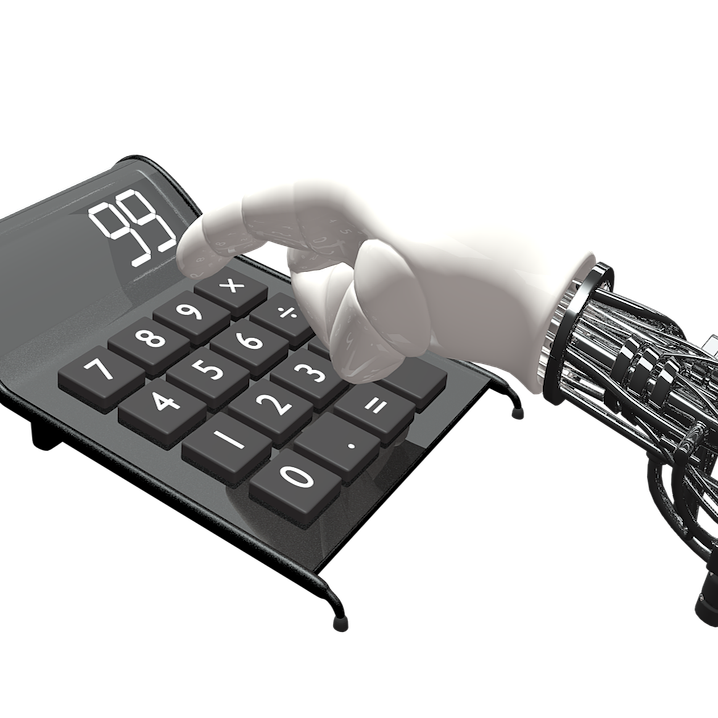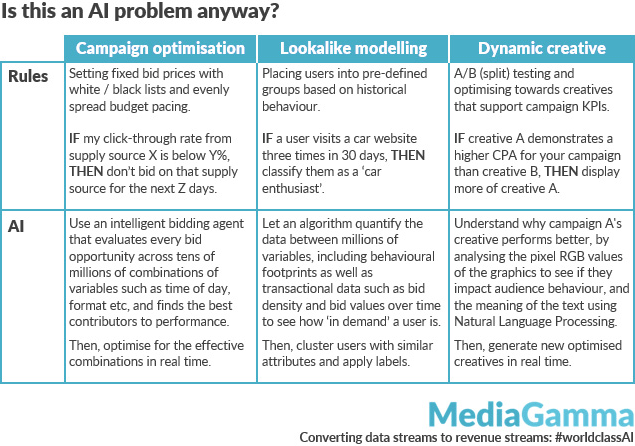Can AI Really Solve Your Problems?
by Lindsay Rowntree on 3rd Oct 2018 in News

In association with MediaGamma
Digital advertising buyers and sellers have a dilemma: as they’re seeing more mention of AI in ad tech conversations, they increasingly wonder whether they should be doing something with AI to gain an advantage, but are unsure exactly what that ‘something’ could be. As a spin-out from University College London (UCL), MediaGamma has the insight into what is – and is not – a suitable problem for an AI solution. This, plus a consultative approach, has led it actually to recommend to some prospective clients that better tools may lie elsewhere. Here, Rael Cline (pictured below), CEO and co-founder of MediaGamma, explains how to decide whether AI might be what you need.
Are you feeling overwhelmed? Do you think AI will help?
If you’re a CMO or ad buyer with a digital ad spend headache, you might say yes, and yes. Everyone you want to reach is skipping between different digital devices, so you don’t know where your audiences are, or what they’re doing. This makes it difficult to get the right ads to the right people. Perhaps AI can help understand them? Everyone seems to say so.
Same goes for the sell side. If you’re a CRO or yield manager, you want to be as sure as possible that you’re presenting digital users with the ads most useful to them, so that they’ll engage. Maybe you need to consider AI, because it optimises, right? And you need to optimise relevance and long term yield…?
Either way, you’re operating in an always-on digital environment where consumers want personalised services, right now – and are prepared to complain publicly if they don’t get both. You’ve lost a lot of power to those consumers over the years. Could you possibly rebalance things with… AI?
Possibly. Maybe. Perhaps. But if you’re saying that every challenge needs an AI solution, then why can’t it help you find your socks in the morning, and why do you still have to feed the cat every night?
You don’t need AI if...
AI – and only AI – can handle scenarios where data sets are complex, big, and fast-changing. Anything else, with less complexity, lower volume, less change, no prediction, and no goal-targeting, is likely to be a software engineering or database issue. If you can identify the difference, you can choose the right tools and be confident you’re getting the best ROI now, and into the future.
But let’s outline what AI is, before we identify what are and are not AI problems.
As a general concept, it’s impossible to nail down. Philosophers have been wrangling with concepts such as ‘consciousness’, ‘thought’, ‘free will’, and ‘mind’ for literally thousands of years.

Rael Cline, CEO & Co-founder, MediaGamma
Practically, however, there are three main AI techniques that are proving useful today. There is supervised learning, in which an algorithm is given historical data inputs and outputs, and learns to predict outputs for those inputs. (“Given all the examples I’ve shown you, where people have clicked my ads in the past, how likely is a user to click this ad in the future?”) There is unsupervised learning, in which an AI system finds patterns for itself: for example, identifying groups of visitors to your site, without any clear distinctions about what defines a ‘group’ from the outset. Taking this a step further, reinforcement learning acts towards a goal through trial and error. Games are a great example of this: give a reinforcement AI the rules of the game, and what defines ‘winning’, and it will iterate until it has developed a strategy that ‘wins’ according to those rules. We cover types of machine learning in more detail on our blog.
So, let’s look at some examples where AI might not be the right tool for you.
Firstly, if you can specify explicit rules, you probably don’t need AI. For example, you might be able to specify something in your demand-side platform like: “If my click-through rate from supply source X is below Y%, don’t bid on that supply source for the next Z days” (see table). Software engineering and good user interface design can take care of this. You don’t need AI.
It’s a similar challenge to consolidating reports across different systems. These don’t change nearly often enough to warrant an AI solution, and they don’t involve prediction. This is a data-engineering problem; and these reports can help with optimising your rules-based DSP, so you don’t need AI here either. You can optimise by combining rules and reports.
Lookalike modelling? Certainly you can create rules that place users into groups depending on the actions they take. For example, you might want to classify someone who visits a car website three times in 30 days as a ‘car enthusiast’ (see table), and this is a very effective, quick way to work, with great short-term ROI.
How about optimising a campaign’s creatives? Everyone knows about A/B testing. Simply test different creatives, use the ones that work, and iterate. Again, no AI required.
You might need AI if...
Where AI can help is when you’re running a rules-based system and it’s becoming overwhelmingly difficult to manage. At first, manual optimisation will probably yield better results than AI, because AI needs time to learn and optimise. However, eventually you could reach a point of complexity and size where AI is a better approach.
![]() So, take the earlier campaign optimisation use case, also illustrated in the table. You can keep adding, changing, and removing rules, but when you have many thousands of ‘X’ sources, with different ‘Y’ percents, and ‘Z’ days, this just doesn’t work any more.
So, take the earlier campaign optimisation use case, also illustrated in the table. You can keep adding, changing, and removing rules, but when you have many thousands of ‘X’ sources, with different ‘Y’ percents, and ‘Z’ days, this just doesn’t work any more.
Enter AI. It loves this stuff. Consider any programmatic bidding opportunity. There may be tens of millions of combinations of variables that contribute to performance, and it’s actually impossible for a human to prioritise the most important ones. For instance, we all know that time of day is important, but how important, exactly? Does this change over the life of a campaign? What if time of day and format are combined? Would this produce a stronger signal than each would individually? How do all these change on a per-impression basis?
Same for lookalike modelling. Your rules about which people to classify as car enthusiasts will work really well at first. But what if conditions change? Will there still be car enthusiasts when all the kids are into Fortnite and cars drive themselves?
So, forget the rules in your DSP. Only an integrated AI layer can evaluate every bidding opportunity on a per-impression basis and optimise a bid price, per bid request, using millions of parameters, in real time. Only AI can dynamically categorise and label user audiences in any given scenario.
The key to thinking about this is really about reframing your problem from one of analysis based on the past, to prediction/action. For example, if you just want to know who are your most valuable LTV customers, so you can segment them based on demographics and location, it’s an analytics problem. Where you might need AI is if you’re asking how you can then use those customers to create new lists to target for new customer acquisition.
This is where AI’s strength really lies. As it iterates and learns, the cost of predictions falls, while accuracy rises – in both cases, dramatically.
You really need AI if...
Looking ahead, AI has a lot to offer in new areas.
For example, consider creative optimisation. Putting together the creative and message is a bottleneck in terms of time and resource, and is extremely difficult to personalise to any significant degree beyond fairly rudimentary A/B analysis.
AI can do this by examining how image factors on a web page or mobile app might influence user behaviour. Every pixel on a screen has an RGB value – that is, how much red, green, and blue go into making that colour. We can determine whether combinations of these values have any effect on how users behave. We can also use natural language processing to understand the copy in the creative. Then we can adapt the creative accordingly, both graphics and copy, for that individual user.
So, let’s go back to that feeling of being overwhelmed. Forget about reports, consolidation, analysis. Forget rules. If you want optimisation, prediction, or action – in real-time, all the time – then AI might just be the solution you’re after.
Then, as with any business problem… talk! Get as much information as you can from experts. Talk until you and your AI partner are both clear on what your challenge is, and how they can help. If their advice is to employ non-AI solutions that will do a better job, then that’s the best possible consultancy money could buy.
But you’ll still need to search for your socks and that cat still looks hungry.









Follow ExchangeWire